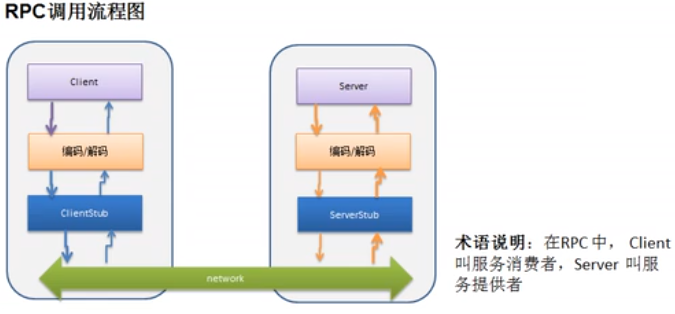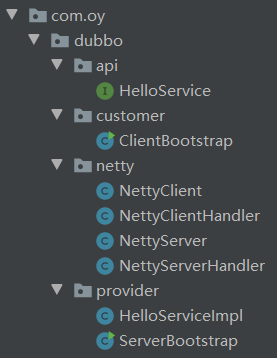1、RPC 基本介绍
RPC(Remote Procedure Call) 远程过程调用,是一个计算机通信协议,该协议允许运行于一台计算机的程序调用另一台计算机的子程序,而程序无需额外地为这个交互作用编程。
两个或多个应用程序都分布在不同的服务器上,它们之间的调用都像是本地方法调用一样。
RPC 调用流程

RPC调用流程说明:
1)服务消费方(client)以本地调用方式调用服务;
2)client stub 接收到调用后负责将方法、参数等封装成能够进行网络传输的消息体
3)client stub 将消息进行编码并发送到服务端
4)server stub 收到消息后进行解码
5)sever stub 根据解码结果调用本地的服务
6)本地服务执行并将结果返回给 server stub
7)server stub 将返回导入结果进行编码并发送至消费方
8)client stub 接收消息并进行解码
9)服务消费方(client)得到结果
小结:RPC 的目标即使将 2-8 这些步骤都封装起来,用户无需关心这些细节,可以像调用本地方法一样即可完成远程服务调用。
2、自己实现 dubbo RPC(基于Netty)
dubbo 底层使用了 Netty 作为网络通信框架,要求用 Netty 实现一个简单的 RPC 框架
模仿 dubbo,消费者和提供者约定接口和协议,消费者远程调用提供者的服务,提供者返回一个字符串,消费者打印提供者返回的数据,底层网络通信使用 Nett有 4.x。
设计说明:
- 创建一个接口,定义抽象方法,用于消费者和提供者之间的约定
- 创建一个提供者,该类需要监听消费者的请求,并按照约定返回数据
- 创建一个消费者,该类需要透明地调用自己不存在的方法,内部需要使用 Netty 请求提供者返回数据


共用接口 HelloService

package com.oy.dubbo.api; public interface HelloService { String hello(String message); }
服务提供方提供的接口 HelloServiceImpl

package com.oy.dubbo.provider; import com.oy.dubbo.api.HelloService; public class HelloServiceImpl implements HelloService { @Override public String hello(String message) { System.out.println("服务提供方 HelloServiceImpl#Hello() 被调用"); // 根据 msg 返回结果 if (message != null) { return "你好,客户端,我已经收到你的消息。你发送的消息是: " + message; } else { return "你好,客户端,我已经收到你的消息。"; } } }
NettyServer 和对应的 ChannelHandler
package com.oy.dubbo.netty; import io.netty.bootstrap.ServerBootstrap; import io.netty.channel.ChannelFuture; import io.netty.channel.ChannelInitializer; import io.netty.channel.ChannelPipeline; import io.netty.channel.nio.NioEventLoopGroup; import io.netty.channel.socket.nio.NioServerSocketChannel; import io.netty.channel.socket.nio.NioSocketChannel; import io.netty.handler.codec.string.StringDecoder; import io.netty.handler.codec.string.StringEncoder; public class NettyServer { public static void startServer(String host, int port) { NioEventLoopGroup boss = new NioEventLoopGroup(1); NioEventLoopGroup work = new NioEventLoopGroup(); try { ServerBootstrap serverBootstrap = new ServerBootstrap(); serverBootstrap .group(boss, work) .channel(NioServerSocketChannel.class) .childHandler(new ChannelInitializer<NioSocketChannel>() { @Override protected void initChannel(NioSocketChannel ch) throws Exception { ChannelPipeline pipeline = ch.pipeline(); pipeline.addLast(new StringDecoder()); pipeline.addLast(new StringEncoder()); pipeline.addLast(new NettyServerHandler()); } }); ChannelFuture channelFuture = serverBootstrap.bind(host, port).sync(); System.out.println("服务端开启服务,端口: " + port); channelFuture.channel().closeFuture().sync(); } catch (Exception e) { e.printStackTrace(); } finally { boss.shutdownGracefully(); work.shutdownGracefully(); } } } package com.oy.dubbo.netty; import com.oy.dubbo.provider.HelloServiceImpl; import io.netty.channel.ChannelHandlerContext; import io.netty.channel.ChannelInboundHandlerAdapter; public class NettyServerHandler extends ChannelInboundHandlerAdapter { @Override public void channelRead(ChannelHandlerContext ctx, Object msg) throws Exception { // 获取客户端发送的消息,并调用服务 System.out.println("收到消费方信息,msg: " + msg); // 客户端在调用服务的 api,需要定义一个协议 // 每次发消息都必须以某个字符串开头 "HelloService#Hello#你好" String s = msg.toString(); if (s.startsWith("HelloService#Hello")) { String result = new HelloServiceImpl().hello(s.substring(s.lastIndexOf("#") + 1)); ctx.writeAndFlush(result); } } @Override public void exceptionCaught(ChannelHandlerContext ctx, Throwable cause) throws Exception { System.out.println("NettyServerHandler exception: " + cause.getMessage()); ctx.close(); } }
服务提供方的服务启动类 ServerBootstrap

package com.oy.dubbo.provider; import com.oy.dubbo.netty.NettyServer; public class ServerBootstrap { public static void main(String[] args) { NettyServer.startServer("127.0.0.1", 10086); } }
客户端程序:
NettyClient
package com.oy.dubbo.netty; import io.netty.bootstrap.Bootstrap; import io.netty.channel.ChannelFuture; import io.netty.channel.ChannelInitializer; import io.netty.channel.ChannelPipeline; import io.netty.channel.nio.NioEventLoopGroup; import io.netty.channel.socket.nio.NioSocketChannel; import io.netty.handler.codec.string.StringDecoder; import io.netty.handler.codec.string.StringEncoder; import java.lang.reflect.Proxy; import java.util.concurrent.ExecutorService; import java.util.concurrent.Executors; public class NettyClient { // 创建线程池 private static ExecutorService excutor = Executors.newFixedThreadPool(Runtime.getRuntime().availableProcessors()); private static NettyClientHandler client; // 使用代理模式,获取一个代理对象 public Object getBean(final Class<?> serviceClass, final String provider) { return Proxy.newProxyInstance(Thread.currentThread().getContextClassLoader(), new Class<?>[]{serviceClass}, (proxy, method, args) -> { if (client == null) { System.out.println("client == null"); initClient(); } // 设置要发给服务器的消息 System.out.println("client != null"); client.setPara(provider + args[0]); return excutor.submit(client).get(); }); } // 初始化客户端 private static void initClient() { client = new NettyClientHandler(); NioEventLoopGroup group = new NioEventLoopGroup(); Bootstrap bootstrap = new Bootstrap(); bootstrap .group(group) .channel(NioSocketChannel.class) .handler(new ChannelInitializer<NioSocketChannel>() { @Override protected void initChannel(NioSocketChannel ch) throws Exception { ChannelPipeline pipeline = ch.pipeline(); pipeline.addLast(new StringDecoder()); pipeline.addLast(new StringEncoder()); pipeline.addLast(client); } }); try { ChannelFuture future = bootstrap.connect("127.0.0.1", 10086).sync(); //future.channel().closeFuture().sync(); } catch (Exception e) { e.printStackTrace(); } // future.addListener(new ChannelFutureListener() { // public void operationComplete(ChannelFuture channelFuture) throws Exception { // if (future.isDone()) { // System.out.println("连接服务器端口 10086 成功"); // } else { // System.out.println("连接服务器端口 10086 失败"); // } // } // }); // future.channel().closeFuture().sync(); } }
NettyClientHandler
package com.oy.dubbo.netty; import io.netty.channel.ChannelHandlerContext; import io.netty.channel.ChannelInboundHandlerAdapter; import java.util.concurrent.Callable; public class NettyClientHandler extends ChannelInboundHandlerAdapter implements Callable { private ChannelHandlerContext context; private String result;// 返回的结果 private String para;// 客户端调用方法时,传入的参数 @Override public void channelActive(ChannelHandlerContext ctx) throws Exception { this.context = ctx; // 其他方法中要用到 ChannelHandlerContext } /** * 收到服务器返回后调用该方法 */ @Override public synchronized void channelRead(ChannelHandlerContext ctx, Object msg) throws Exception { result = msg.toString(); System.out.println("NettyClientHandler#channelRead() 被调用, result=" + result); notify(); // 唤醒等待的线程 } /** * 被代理对象调用,发送数据给服务器,wait,等待被 channelRead 唤醒 */ @Override public synchronized Object call() throws Exception { context.writeAndFlush(para); wait(); // 等待 channelRead 方法获取服务器返回结果后唤醒 return result; } @Override public void exceptionCaught(ChannelHandlerContext ctx, Throwable cause) throws Exception { ctx.close(); } public void setPara(String para) { this.para = para; } }
ClientBootstrap
package com.oy.dubbo.customer; import com.oy.dubbo.api.HelloService; import com.oy.dubbo.netty.NettyClient; public class ClientBootstrap { // 定义协议头 public static final String providerName = "HelloService#Hello#"; public static void main(String[] args) { // 创建一个消费者 NettyClient customer = new NettyClient(); System.out.println("1"); // 创建代理对象 HelloService service = (HelloService) customer.getBean(HelloService.class, providerName); System.out.println("2"); // 通过代理对象调用服务器提供者的方法(服务) String result = service.hello("你好 dubbo"); System.out.println("3"); System.out.println("消费者调用提供者方法,返回的结果:result=" + result);
---
